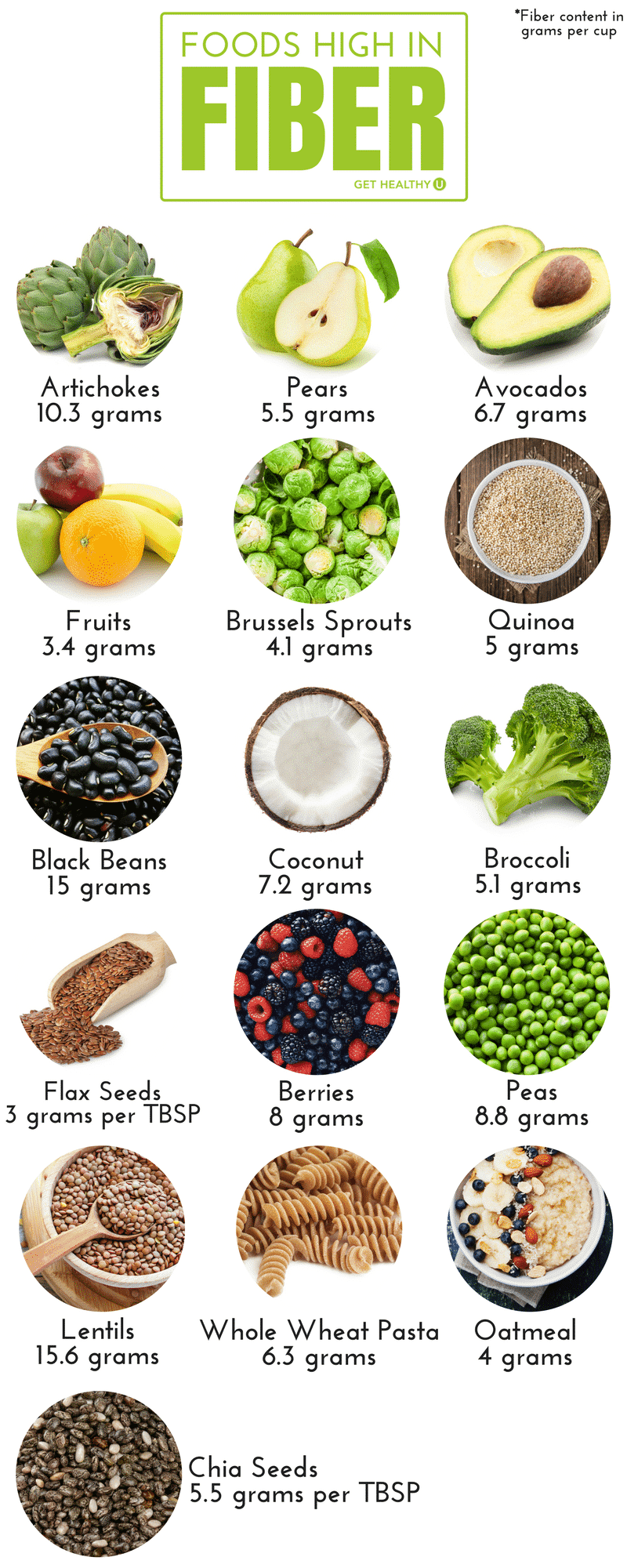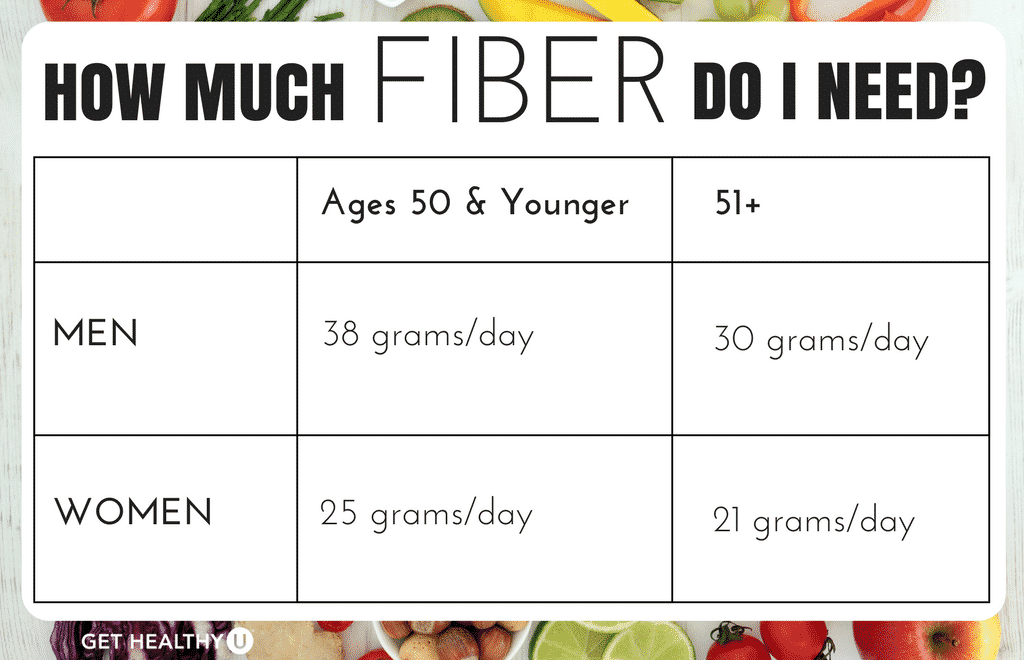Incorporating good sources of fiber into your food regimen is without doubt one of the best and only methods to assist weight reduction whereas enhancing your total well being.
I get requested these questions on a regular basis:
- How a lot fiber ought to I be consuming each day?
- What’s the distinction between soluble and insoluble fiber?
- What are pure sources of fiber?
When you have these questions, too, you’re not alone and also you’re in the best place! Fiber is a generally misunderstood nutrient that’s important to enhancing intestine well being, in addition to on a regular basis well being.
On this article I’ll discover what fiber is, the several types of fiber, pure sources of fiber, advantages to incorporating fiber in your food regimen, and the way a lot fiber try to be consuming each day.

What’s Fiber? The place Can I Get It?
Fiber is a plant-based nutrient sometimes called “roughage” or “bulk” that helps effectively transfer meals via the physique. Fiber solely comes from plant-based meals, and sadly, most Individuals don’t eat practically sufficient fiber each day!
Fiber is present in a plethora of meals, lots of which you will have already got in your typical food regimen, however not in a excessive sufficient amount. It’s only present in meals that come from crops, so fruits, greens, grains, beans, and seeds are all nice sources.
These meals include few energy however tons of advantages, so including these pure sources of fiber to your food regimen (in case you haven’t already!) is a good, straightforward concept that may additionally lead to weight reduction and higher total well being!
Pure Sources of Fiber
Listed here are a few of the greatest sources of pure fiber that you need to be sure to include into your food regimen for weight reduction and total well being advantages.
I’ve additionally included the approximate fiber content material per serving so you may get concept which of those meals packs the largest fiber punch!
- Lentils (15.6 grams)
- Black beans (15 grams)
- Artichokes (10.3 grams)
- Avocados (10 grams)
- Chia seeds (10 grams)
- Peas (8.8 grams)
- Flax Seeds (8 grams)
- Berries (Blackberries: 7.6g, blueberries: 3.6g, strawberries: 3g, raspberries: 8g)
- Coconut (7 grams)
- Entire wheat pasta (6 grams)
- Pears (5.5 grams)
- Ardour Fruit (5 grams)
- Broccoli (5 grams)
- Quinoa (5 grams)
- Buckwheat (4.5 grams)
- Brussels sprouts (4 grams)
- Oatmeal (4 grams)
- Almonds (3.5 grams)
- Fruits (Bananas: 3.1g, apples: 4.4g, oranges: 3.1g)
- Mango (3 grams)
- Pecans (2.7 grams)
- Sunflower Seeds (2.4 grams)
- Peanuts (2.4 grams)
- Pumpkin Seeds (1.7 grams)
I usually get requested about fiber dietary supplements, and I all the time say the identical factor: I’ve no downside with fiber dietary supplements, but it surely’s fairly straightforward to get fiber naturally out of your food regimen.
Not solely are the meals which can be highest in fiber straightforward to return by, they’re scrumptious! Be at liberty to take the supplemental route and add a dose of Metamucil to your day, however I a lot favor a bowl of berries or a scoop of chia seeds in our morning smoothie. Pure sources of fiber style nice!


What are the Variations Between Pure Sources of Fiber?
There are two several types of fiber: soluble fiber and insoluble fiber, and there are just a few variations between them.
Soluble Fiber
Soluble fiber dissolves in water and kinds a gel-like materials that slows down the physique’s digestion of meals.
Based on the Mayo Clinic: “Soluble fiber dissolves with water and creates a gel-like substance that helps to decrease blood ldl cholesterol and glucose ranges.”
Soluble fiber is understood to decrease blood ldl cholesterol, lower your threat of coronary heart illness, decrease glucose ranges, decelerate digestion (making you’re feeling full longer!), enhance immunity, act as an inflammatory, and an elevated consumption in soluble fiber is linked to weight reduction.
Insoluble Fiber
Insoluble fiber is the kind of fiber usually known as “roughage.”
The Mayo Clinic states: “Insoluble fiber absorbs water which provides bulk to your digestive tract and helps to maneuver issues via rapidly.”
The sort of fiber doesn’t dissolve in water, and isn’t damaged down and absorbed into the bloodstream the best way soluble fiber it.
Insoluble fiber promotes motion of fabric via the digestive system, which may be notably useful for individuals who battle with constipation.
Many plant-based meals include each forms of fiber, and each forms of fiber are nice for you!
6 Advantages of Fiber for Higher Wellness
Fiber is important for total well being, providing a variety of advantages that assist all the pieces from digestive well being to weight administration and coronary heart well being.
1. Controls your blood sugar ranges
Once you eat meals excessive in fiber, your physique absorbs sugar slower, stopping your blood glucose ranges from rising too rapidly.
Discover extra meals that may assist decrease blood sugar naturally!
2. Makes your intestines transfer quicker, aids in constipation, and retains you common
Fiber absorbs water, which accelerates bowel actions and retains your intestines working.
3. Helps stop coronary heart illness, diabetes, digestive issues, and weight achieve
By serving to management your blood sugar, normalizing your bowel actions, growing your intestine well being, and aiding in decrease caloric consumption because of preserving you full longer, fiber prevents in opposition to these well being points.
4. Aids in weight reduction
Some forms of fiber sluggish the absorption of vitamins, permitting you to really feel full longer, due to this fact consuming much less energy all through the day.
Discover my favourite ideas for eliminating menopause stomach fats!
5. Lowers ldl cholesterol
This profit is considerably contested, as a result of it isn’t true in all circumstances, however heightened fiber consumption has been linked to lowered blood levels of cholesterol in a number of research (like this one from the American Journal of Scientific Diet)
Uncover 12 meals that decrease your ldl cholesterol!
6. Promotes good intestine well being, bowel well being & wholesome intestine micro organism
“Good” micro organism enzymes within the massive gut “feed” on fiber, whereas different forms of meals (protein, carbs, and so on) are damaged down earlier than they attain your intestines, thereby growing our variety of good intestine micro organism, which helps your total well being.
Discover 7 straightforward methods I improved my intestine well being over 50!
How A lot Fiber Ought to I be Consuming?
Like many necessary vitamins, Individuals usually don’t eat sufficient fiber in a day. If you happen to’re a typical American, you’re in all probability consuming someplace between 10 and 15 grams of fiber every day, which is approach beneath the really helpful quantity!
Based on The Meals and Diet Board of the Institute of Medication, males want between 30 and 38 grams of fiber per day, and girls want between 21 and 25 grams per day.
The exception to those pointers is for girls who’re pregnant or nursing, who ought to devour 28 to 29 grams of fiber day by day.


Viscous Fiber Can Assist You Lose Weight
Analysis on viscous fiber suggests it might cut back your urge for food and enable you to eat much less.
To drop a few pounds, it’s essential to be in a calorie deficit. Counting energy will help many individuals — but it surely isn’t essential in case you select the best meals.
Something that curbs urge for food can lower what number of energy you devour, and this will likely imply which you can drop a few pounds with out having to work so arduous on calorie crunching.
Fiber consumption has been proven to suppress starvation. But, just one kind of fiber is discovered to have this particular impact. The thicker, or extra viscous, the fiber, the higher it’s at decreasing urge for food. Which means, the less energy you eat!
What’s viscous fiber? Viscous fibers are dietary fibers that can not be dissolved by liquids resembling water due to its excessive molecular weight. The most typical kind of viscous fiber are both present in skins or psyllium husks, it’s additionally the kind of fiber that’s identified for its capability to type a viscous gel-like construction when combined with water.
The well being advantages of viscous fiber embody aiding to make the intestine extra common which is sweet for digestion particularly when you’ve got irritable bowel syndrome or IBS.
Viscous fibers are unique to plant meals, wealthy sources embody beans, flax seeds, asparagus, and brussels sprouts. If you happen to’re happening a excessive fiber food regimen make gradual changes to your physique’s wants for time make adjustments.
Good Sources of Fiber FAQ
Lentils (15.6 grams), black beans (15 grams), artichokes (10.3 grams), avocados (10 grams), and chia seeds (10 grams) are all meals excessive in fiber. Take a look at my listing above to see extra good sources of fiber, listed by grams of fiber per serving.
To get 30g of fiber a day, concentrate on incorporating quite a lot of fiber-rich meals into every meal and snack. I personally love including chia seeds to my morning smoothie, and specializing in fiber-packed salads. Snacking on nuts like almonds or sunflower seeds can even enhance your fiber consumption. By mixing these meals into your day by day meals, you’ll simply meet your fiber objectives.
The very best forms of fiber for selling wholesome bowel actions are soluble and insoluble fiber. Soluble fiber, present in meals like oats, beans, apples, and citrus fruits, helps soften stool by absorbing water, making it simpler to go. Insoluble fiber, present in entire grains, greens, and nuts, provides bulk to the stool and helps it transfer via the digestive tract extra effectively. A stability of each forms of fiber in your food regimen will help preserve common bowel actions and forestall constipation.
Drinks which can be excessive in fiber embody smoothies made with fiber-rich vegatables and fruits, resembling berries, spinach, and avocados. Including chia seeds, flaxseeds, or oats to your smoothie can enhance its fiber content material as properly. Different choices embody vegetable juices, notably these made with high-fiber veggies like carrots, celery, and kale. Moreover, fiber-fortified drinks, resembling sure fruit juices or ready-made fiber drinks, are stocked in shops. Consuming loads of water alongside fiber-rich drinks is important to assist fiber transfer via your digestive system successfully.









Discussion about this post